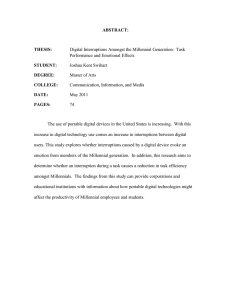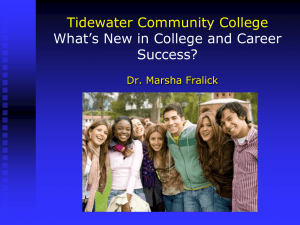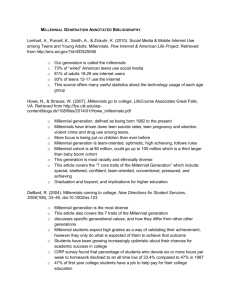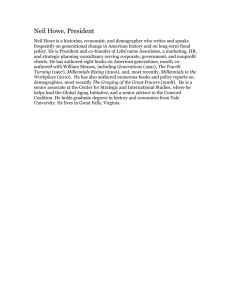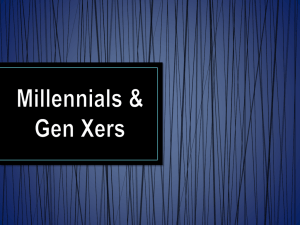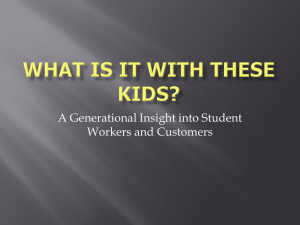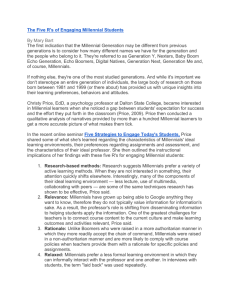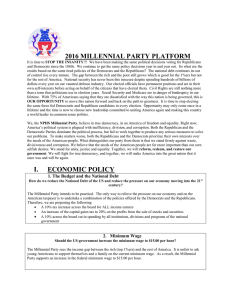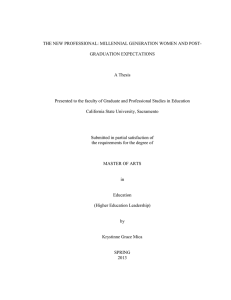Teaching and Learning in the Age of Millennials Barbara Hornum, Ph.D. Director
advertisement
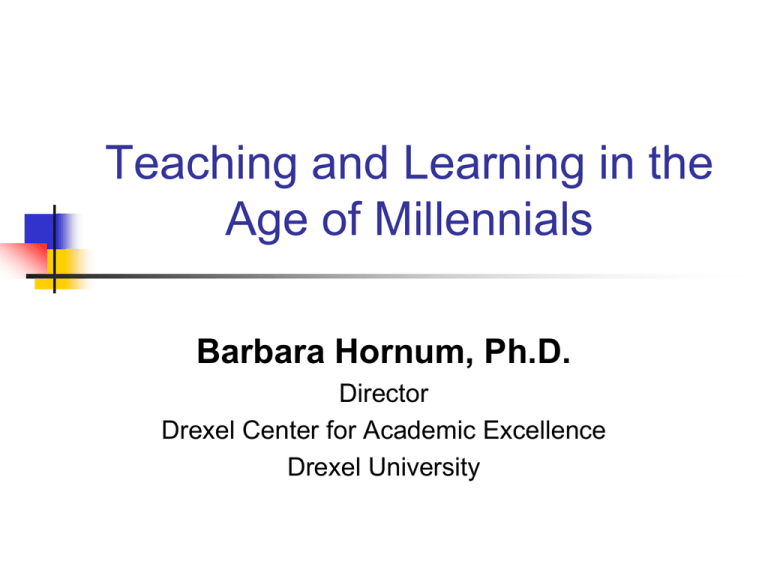
Teaching and Learning in the Age of Millennials Barbara Hornum, Ph.D. Director Drexel Center for Academic Excellence Drexel University Issues Millennial students are a new campus cohort. They have some characteristics in terms of values and behaviors that differ from previous cohorts who are now faculty, academic staff and administrators and may conflict at times. Issues Continued Understanding the differences can be useful in assisting faculty to establish patterns of classroom management that can minimize faculty stress while promoting effective student learning. It is beneficial to the learning situation for faculty to individually and collectively look at “typical” millennial behaviors to reduce friction and the risks of disengaged students and negative faculty evaluations. Some Millennial Expectations Four areas that recur in discussions and reflect the literature are: Millennials’ High Performance Expectations. Desire for Structural Clarity. Technological Connectedness for Instant Communication. Strong Peer Group Orientation Expectations Continued These expectations have connected correlates that impact the teaching/learning nexus. High Performance Expectations: Positive Aspects: Students are motivated to work hard in order to do well. Will take direction that helps them achieve. Expectations Continued High Performance Expectations: Negative Aspects: Students are not accustomed to having their work criticized. Expect that they are the “center of the universe.” Have frequently experienced grade inflation and assume it as a right. They see themselves as special. Behavioral Responses: Students and faculty have different views of acceptable grades. Students may blame the faculty for not getting As and either drop the course, complain about the faculty member either on end of term evaluations or to a department head, or request make-up exams or extra credit work. These may result in problems for faculty in merit increases, or other faculty rewards linked to student evaluations of teaching. Expectations Continued Desire for Structural Clarity: Positive Aspects: Students are responsive to very clear guidelines. Really want to know details of what professors expect. Cause and effect operational behavior. Negative Aspects: Students uncomfortable with open-ended assignments. Expect faculty to provide high levels of personal involvement and attention on demand. Need to be sure that they have step-by-step guidance. Expectations Continued Behavioral Responses: Syllabi need to be very explicit about course goals and objectives. Every assignment should be explained with details as to grading factors. Communication processes have to be established, e.g. “ I check e-mail at 8 P.M. You can expect a response by……” Clarify all rules for attendance, lateness, late assignments, missed exams. Be clear what students can and cannot expect from you. Expectations Continued Instant Communication via Technology: Positive Aspects: Students are reachable by e-mail blasts when you want to contact class as a whole. Individual students also respond to e-mails. Students are web savvy and comfortable with assignments that involve the web. Comfortable with using computers. Expectations Continued Negative Aspects: Students may make assumptions that you will spend as much time online as they do and thus can be upset and see you as nonresponsive when you do not reply instantly. Many students have moved on from e-mail to texting and twittering. Students may feel free to use cell phones and laptops in class for non-class activities. Some students make assumptions that any data on the web are valid. Expectations Continued Behavioral Responses: Some of the same suggestions as indicated for other Expectations apply here. Since some students may have more than one e-mail address you should establish which one you will use to contact them. Using the official university address is generally most useful. If you will only use e-mail and no other forms of contact, be clear. You need to decide, if, when, and how you will allow technology in the classroom. Linked to this is whether you want to engage students in this discussion. Expectations Continued Strong Peer Group Orientation: Positive Aspects: Millennial students like to interact with one another frequently and in a variety of modes. Students willingly participate in group and team projects. Negative Aspects: Students using technology in class to “talk” to friends may lose focus on coursework. Some students are reluctant to disagree with one another in discussions nor will they openly express views that might be challenged. Faculty need to recognize the possibility of “group think” on issues but also on their performance. Expectations Continued Behavioral Responses: Building in learning experiences that involve peer interactions can be beneficial, e.g. study groups. Present inappropriate and distracting forms of communication such as texting as a problem for the class to solve collectively. Be careful not to criticize students publicly. This includes using sarcasm, off-hand comments, etc. Public positive statements about taking positions on issues can reinforce the desired behavior. Millennials and Stress There have been a number of articles recently dealing with stress and anxiety among Freshman Students with no experience with making mistakes and learning from them will magnify suggestions for improvement into FAILURE! Millennials and Stress Continued Faculty should try to present critiques in formative terms as well as summative Work with advisors and counselors when students seem depressed or withdrawn Have ways of reducing your own stress Things to Consider on Your Own How do the issues and expectations described here fit within your experiences? What would you add or eliminate? Are there other Behavioral Responses you have used that you would suggest? Online Resources Planning for Higher Education: (http://www1.scup.org/PHE/FMPro?-db=PHE.fp5&-lay=Home&-format=home.htm&-FindAny) Owen, J. & Rodolfa, E. (2009). Prevention through connection: Creating a campus climate of care. Planning for Higher Education 37 (2), pp. 26-33. To be made available online soon. Pagani, F. ( 2008). The inheritance of Millennial students: What they will inherit from their campus experience – what legacy will they leave. Planning for Higher Education 37 (1), pp. 49-58. Online Resources Continued Rickes, P. C. (2009). Make way for Millennials: How today’s students are shaping higher education space. Planning for Higher Education 37 (2), pp. 7-17. To be made available online soon. Ruffo, J. A. (2008). Introduction: “Millennial” or “Net Generation” students and their impact on the development of student-centered facilities. Planning for Higher Education 37 (1), pp. 5-6. Wandel, T. L. (2008). Colleges and universities want to be your friend: Communicating via online social networking. Planning for Higher Education 37 (1), pp. 35-48 Additional References Howe, N. & Strauss, W. (2007). Millennials go to college. Great Falls, VA: Life Course Associates . Howe, N. & Strauss, W. (2000). Millennials rising: The next great generation. New York: Vintage Books. Sax, L.J. (2003), Our incoming students: What are they like? About Campus 8 (3), pp. 15-20. Strauss, W. & Howe, N. (1991). Generations: The history of America’s future, 1584 to 2069. New York: Morrow. Wilson, M.E. (2004). Teaching, learning, and Millennial students. In M. D. Coomes & R. DeBard (Eds.), Serving the Millennial Generation, New Directions for Student Services 106 (Summer 2004), pp. 59-71. Contact Information Barbara Hornum, Ph.D. Director Drexel Center for Academic Excellence Drexel University Tel: 215-895-4904 E-Mail: hornumbg@drexel.edu

